EDU10003: Maths Assignment - The World of Maths, Semester 1
VerifiedAdded on 2022/09/06
|6
|1473
|21
Essay
AI Summary
This essay addresses the Grimley quote, differentiating between mathematics and numeracy. It defines mathematics as the study of numbers and theoretical concepts, while numeracy focuses on applying mathematical knowledge in daily life. The essay explores the similarities and differences between the two terms, emphasizing the practical application of numeracy skills in managing finances and business operations. It also examines the Fibonacci sequence in sunflowers as a natural phenomenon explained by mathematical concepts. The conclusion reiterates the distinct nature of mathematics and numeracy, highlighting the importance of both in solving real-world problems and the need for confidence in applying mathematical concepts. The essay uses references to support its arguments and provide context to the concepts discussed. The assignment aims to show the importance of understanding both numeracy and mathematics and their applications in real life.
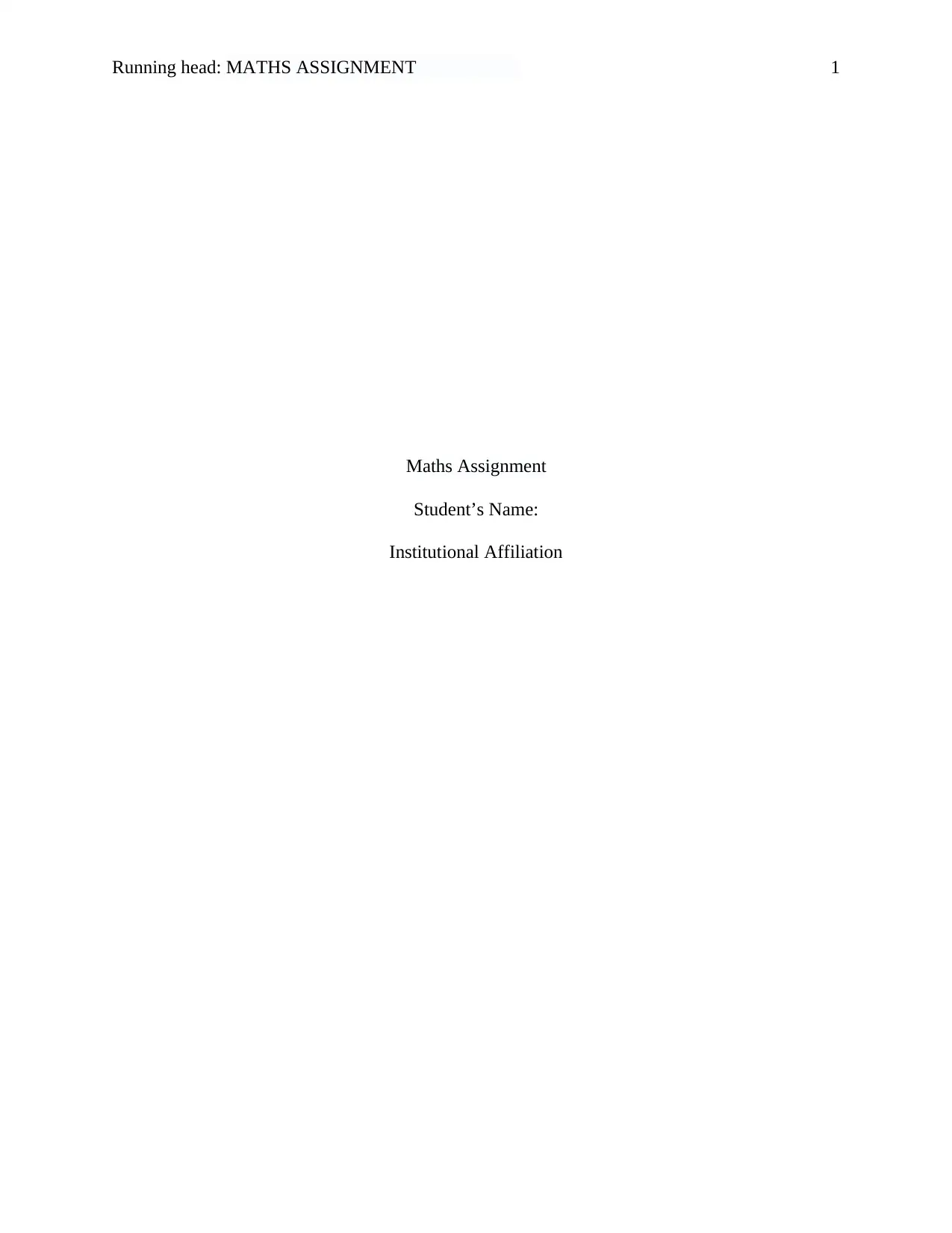
Running head: MATHS ASSIGNMENT 1
Maths Assignment
Student’s Name:
Institutional Affiliation
Maths Assignment
Student’s Name:
Institutional Affiliation
Paraphrase This Document
Need a fresh take? Get an instant paraphrase of this document with our AI Paraphraser
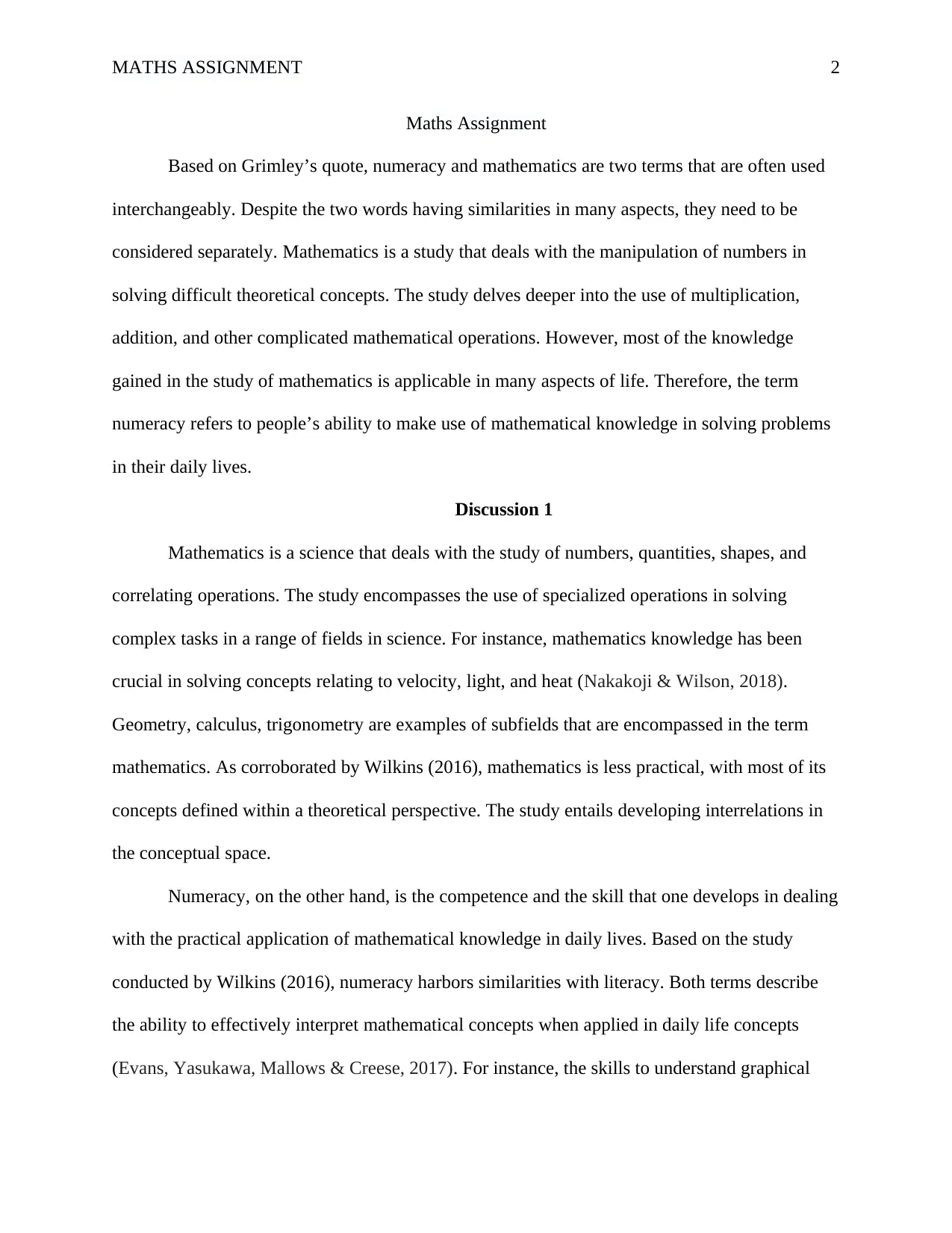
MATHS ASSIGNMENT
Maths Assignment
Based on Grimley’s quote, numeracy and mathematics are two terms that are often used
interchangeably. Despite the two words having similarities in many aspects, they need to be
considered separately. Mathematics is a study that deals with the manipulation of numbers in
solving difficult theoretical concepts. The study delves deeper into the use of multiplication,
addition, and other complicated mathematical operations. However, most of the knowledge
gained in the study of mathematics is applicable in many aspects of life. Therefore, the term
numeracy refers to people’s ability to make use of mathematical knowledge in solving problems
in their daily lives.
Discussion 1
Mathematics is a science that deals with the study of numbers, quantities, shapes, and
correlating operations. The study encompasses the use of specialized operations in solving
complex tasks in a range of fields in science. For instance, mathematics knowledge has been
crucial in solving concepts relating to velocity, light, and heat (Nakakoji & Wilson, 2018).
Geometry, calculus, trigonometry are examples of subfields that are encompassed in the term
mathematics. As corroborated by Wilkins (2016), mathematics is less practical, with most of its
concepts defined within a theoretical perspective. The study entails developing interrelations in
the conceptual space.
Numeracy, on the other hand, is the competence and the skill that one develops in dealing
with the practical application of mathematical knowledge in daily lives. Based on the study
conducted by Wilkins (2016), numeracy harbors similarities with literacy. Both terms describe
the ability to effectively interpret mathematical concepts when applied in daily life concepts
(Evans, Yasukawa, Mallows & Creese, 2017). For instance, the skills to understand graphical
2
Maths Assignment
Based on Grimley’s quote, numeracy and mathematics are two terms that are often used
interchangeably. Despite the two words having similarities in many aspects, they need to be
considered separately. Mathematics is a study that deals with the manipulation of numbers in
solving difficult theoretical concepts. The study delves deeper into the use of multiplication,
addition, and other complicated mathematical operations. However, most of the knowledge
gained in the study of mathematics is applicable in many aspects of life. Therefore, the term
numeracy refers to people’s ability to make use of mathematical knowledge in solving problems
in their daily lives.
Discussion 1
Mathematics is a science that deals with the study of numbers, quantities, shapes, and
correlating operations. The study encompasses the use of specialized operations in solving
complex tasks in a range of fields in science. For instance, mathematics knowledge has been
crucial in solving concepts relating to velocity, light, and heat (Nakakoji & Wilson, 2018).
Geometry, calculus, trigonometry are examples of subfields that are encompassed in the term
mathematics. As corroborated by Wilkins (2016), mathematics is less practical, with most of its
concepts defined within a theoretical perspective. The study entails developing interrelations in
the conceptual space.
Numeracy, on the other hand, is the competence and the skill that one develops in dealing
with the practical application of mathematical knowledge in daily lives. Based on the study
conducted by Wilkins (2016), numeracy harbors similarities with literacy. Both terms describe
the ability to effectively interpret mathematical concepts when applied in daily life concepts
(Evans, Yasukawa, Mallows & Creese, 2017). For instance, the skills to understand graphical
2
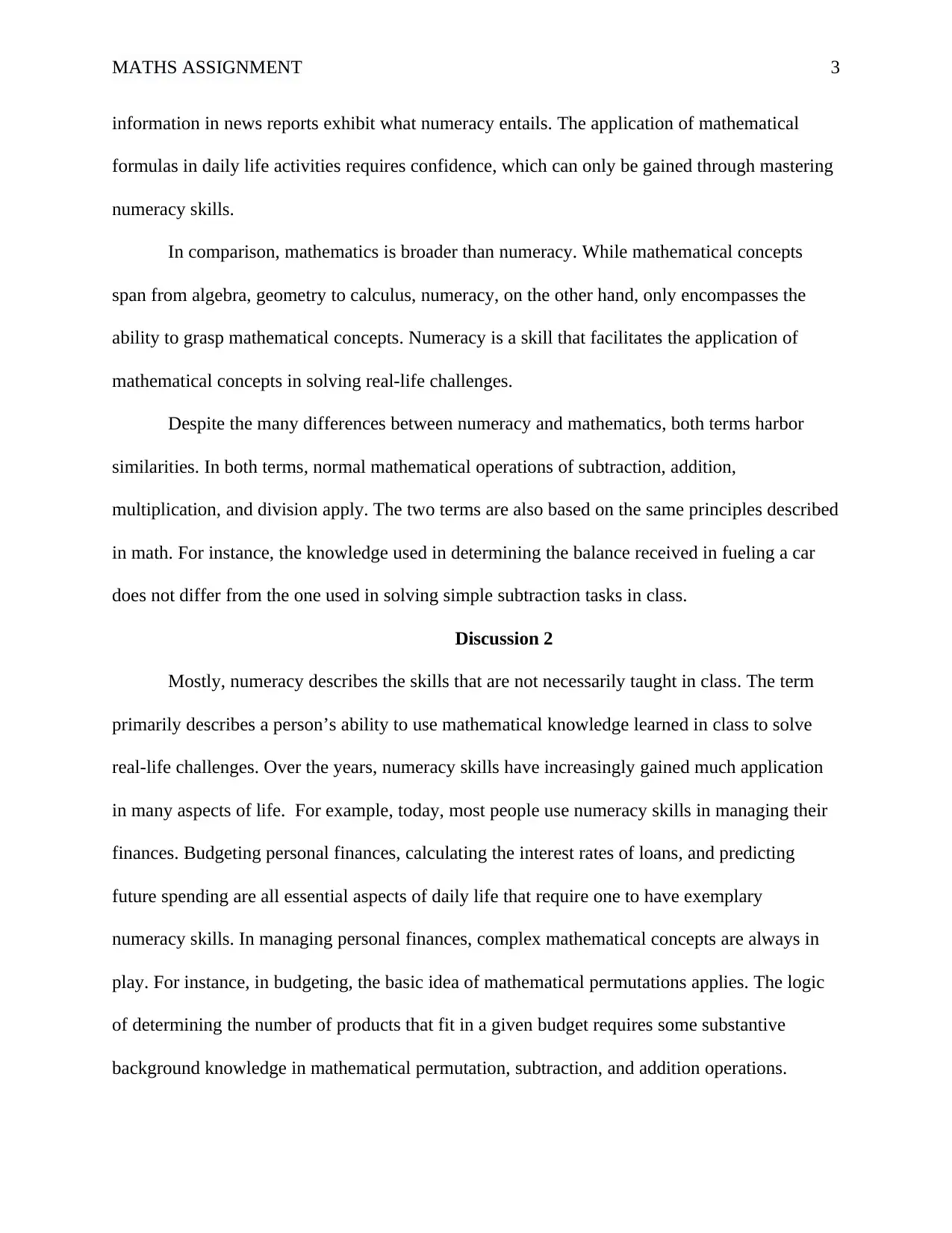
MATHS ASSIGNMENT
information in news reports exhibit what numeracy entails. The application of mathematical
formulas in daily life activities requires confidence, which can only be gained through mastering
numeracy skills.
In comparison, mathematics is broader than numeracy. While mathematical concepts
span from algebra, geometry to calculus, numeracy, on the other hand, only encompasses the
ability to grasp mathematical concepts. Numeracy is a skill that facilitates the application of
mathematical concepts in solving real-life challenges.
Despite the many differences between numeracy and mathematics, both terms harbor
similarities. In both terms, normal mathematical operations of subtraction, addition,
multiplication, and division apply. The two terms are also based on the same principles described
in math. For instance, the knowledge used in determining the balance received in fueling a car
does not differ from the one used in solving simple subtraction tasks in class.
Discussion 2
Mostly, numeracy describes the skills that are not necessarily taught in class. The term
primarily describes a person’s ability to use mathematical knowledge learned in class to solve
real-life challenges. Over the years, numeracy skills have increasingly gained much application
in many aspects of life. For example, today, most people use numeracy skills in managing their
finances. Budgeting personal finances, calculating the interest rates of loans, and predicting
future spending are all essential aspects of daily life that require one to have exemplary
numeracy skills. In managing personal finances, complex mathematical concepts are always in
play. For instance, in budgeting, the basic idea of mathematical permutations applies. The logic
of determining the number of products that fit in a given budget requires some substantive
background knowledge in mathematical permutation, subtraction, and addition operations.
3
information in news reports exhibit what numeracy entails. The application of mathematical
formulas in daily life activities requires confidence, which can only be gained through mastering
numeracy skills.
In comparison, mathematics is broader than numeracy. While mathematical concepts
span from algebra, geometry to calculus, numeracy, on the other hand, only encompasses the
ability to grasp mathematical concepts. Numeracy is a skill that facilitates the application of
mathematical concepts in solving real-life challenges.
Despite the many differences between numeracy and mathematics, both terms harbor
similarities. In both terms, normal mathematical operations of subtraction, addition,
multiplication, and division apply. The two terms are also based on the same principles described
in math. For instance, the knowledge used in determining the balance received in fueling a car
does not differ from the one used in solving simple subtraction tasks in class.
Discussion 2
Mostly, numeracy describes the skills that are not necessarily taught in class. The term
primarily describes a person’s ability to use mathematical knowledge learned in class to solve
real-life challenges. Over the years, numeracy skills have increasingly gained much application
in many aspects of life. For example, today, most people use numeracy skills in managing their
finances. Budgeting personal finances, calculating the interest rates of loans, and predicting
future spending are all essential aspects of daily life that require one to have exemplary
numeracy skills. In managing personal finances, complex mathematical concepts are always in
play. For instance, in budgeting, the basic idea of mathematical permutations applies. The logic
of determining the number of products that fit in a given budget requires some substantive
background knowledge in mathematical permutation, subtraction, and addition operations.
3
⊘ This is a preview!⊘
Do you want full access?
Subscribe today to unlock all pages.

Trusted by 1+ million students worldwide
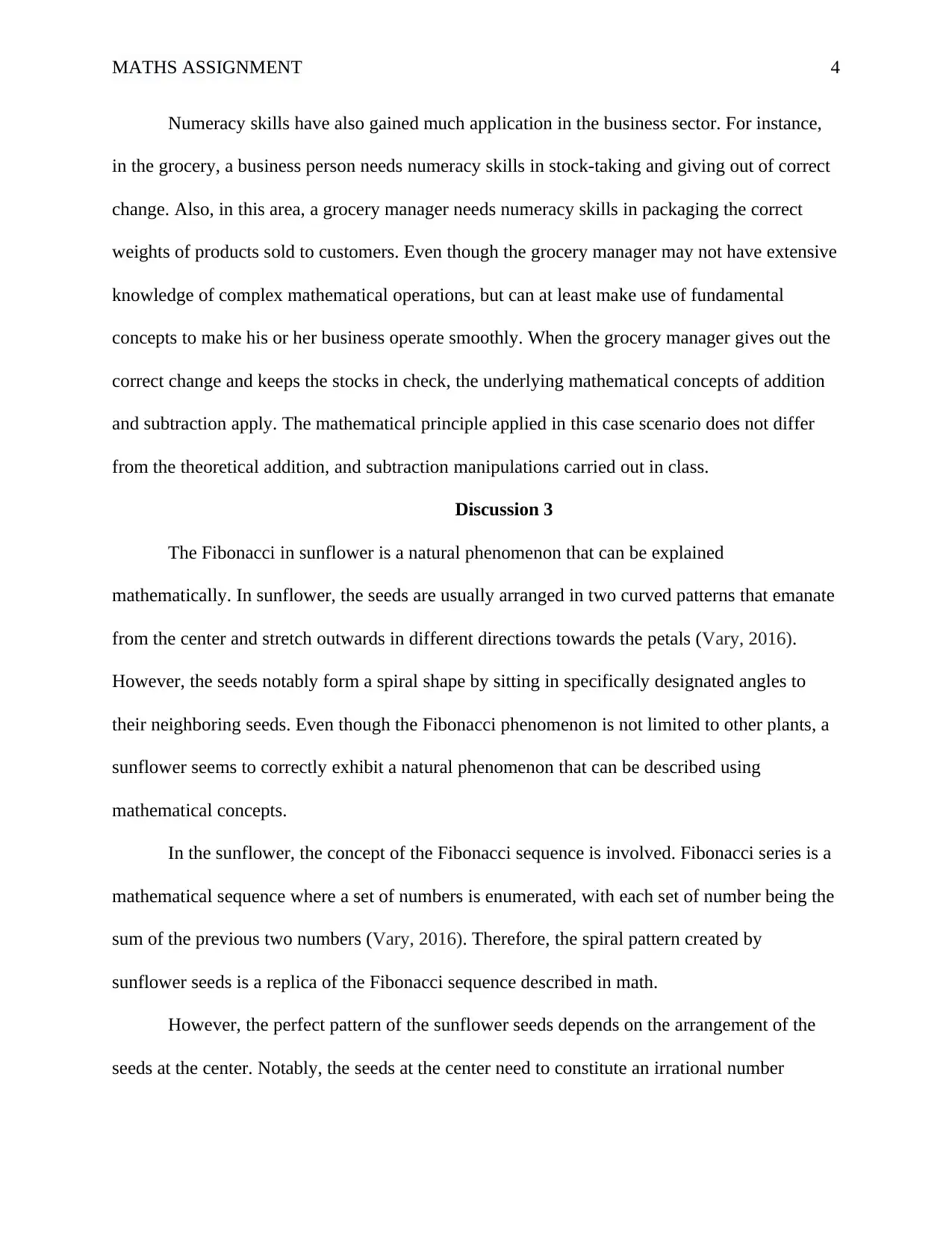
MATHS ASSIGNMENT
Numeracy skills have also gained much application in the business sector. For instance,
in the grocery, a business person needs numeracy skills in stock-taking and giving out of correct
change. Also, in this area, a grocery manager needs numeracy skills in packaging the correct
weights of products sold to customers. Even though the grocery manager may not have extensive
knowledge of complex mathematical operations, but can at least make use of fundamental
concepts to make his or her business operate smoothly. When the grocery manager gives out the
correct change and keeps the stocks in check, the underlying mathematical concepts of addition
and subtraction apply. The mathematical principle applied in this case scenario does not differ
from the theoretical addition, and subtraction manipulations carried out in class.
Discussion 3
The Fibonacci in sunflower is a natural phenomenon that can be explained
mathematically. In sunflower, the seeds are usually arranged in two curved patterns that emanate
from the center and stretch outwards in different directions towards the petals (Vary, 2016).
However, the seeds notably form a spiral shape by sitting in specifically designated angles to
their neighboring seeds. Even though the Fibonacci phenomenon is not limited to other plants, a
sunflower seems to correctly exhibit a natural phenomenon that can be described using
mathematical concepts.
In the sunflower, the concept of the Fibonacci sequence is involved. Fibonacci series is a
mathematical sequence where a set of numbers is enumerated, with each set of number being the
sum of the previous two numbers (Vary, 2016). Therefore, the spiral pattern created by
sunflower seeds is a replica of the Fibonacci sequence described in math.
However, the perfect pattern of the sunflower seeds depends on the arrangement of the
seeds at the center. Notably, the seeds at the center need to constitute an irrational number
4
Numeracy skills have also gained much application in the business sector. For instance,
in the grocery, a business person needs numeracy skills in stock-taking and giving out of correct
change. Also, in this area, a grocery manager needs numeracy skills in packaging the correct
weights of products sold to customers. Even though the grocery manager may not have extensive
knowledge of complex mathematical operations, but can at least make use of fundamental
concepts to make his or her business operate smoothly. When the grocery manager gives out the
correct change and keeps the stocks in check, the underlying mathematical concepts of addition
and subtraction apply. The mathematical principle applied in this case scenario does not differ
from the theoretical addition, and subtraction manipulations carried out in class.
Discussion 3
The Fibonacci in sunflower is a natural phenomenon that can be explained
mathematically. In sunflower, the seeds are usually arranged in two curved patterns that emanate
from the center and stretch outwards in different directions towards the petals (Vary, 2016).
However, the seeds notably form a spiral shape by sitting in specifically designated angles to
their neighboring seeds. Even though the Fibonacci phenomenon is not limited to other plants, a
sunflower seems to correctly exhibit a natural phenomenon that can be described using
mathematical concepts.
In the sunflower, the concept of the Fibonacci sequence is involved. Fibonacci series is a
mathematical sequence where a set of numbers is enumerated, with each set of number being the
sum of the previous two numbers (Vary, 2016). Therefore, the spiral pattern created by
sunflower seeds is a replica of the Fibonacci sequence described in math.
However, the perfect pattern of the sunflower seeds depends on the arrangement of the
seeds at the center. Notably, the seeds at the center need to constitute an irrational number
4
Paraphrase This Document
Need a fresh take? Get an instant paraphrase of this document with our AI Paraphraser
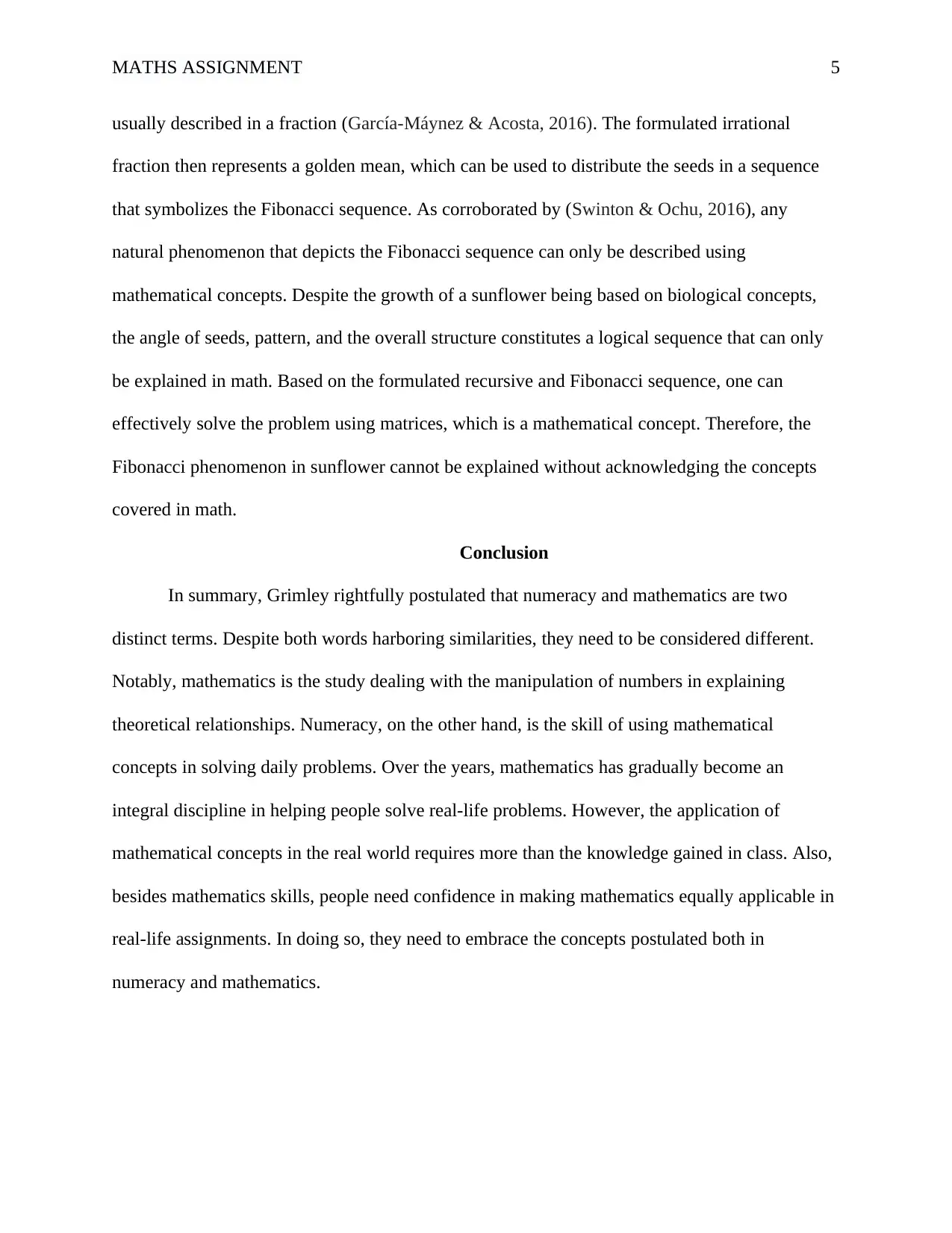
MATHS ASSIGNMENT
usually described in a fraction (García-Máynez & Acosta, 2016). The formulated irrational
fraction then represents a golden mean, which can be used to distribute the seeds in a sequence
that symbolizes the Fibonacci sequence. As corroborated by (Swinton & Ochu, 2016), any
natural phenomenon that depicts the Fibonacci sequence can only be described using
mathematical concepts. Despite the growth of a sunflower being based on biological concepts,
the angle of seeds, pattern, and the overall structure constitutes a logical sequence that can only
be explained in math. Based on the formulated recursive and Fibonacci sequence, one can
effectively solve the problem using matrices, which is a mathematical concept. Therefore, the
Fibonacci phenomenon in sunflower cannot be explained without acknowledging the concepts
covered in math.
Conclusion
In summary, Grimley rightfully postulated that numeracy and mathematics are two
distinct terms. Despite both words harboring similarities, they need to be considered different.
Notably, mathematics is the study dealing with the manipulation of numbers in explaining
theoretical relationships. Numeracy, on the other hand, is the skill of using mathematical
concepts in solving daily problems. Over the years, mathematics has gradually become an
integral discipline in helping people solve real-life problems. However, the application of
mathematical concepts in the real world requires more than the knowledge gained in class. Also,
besides mathematics skills, people need confidence in making mathematics equally applicable in
real-life assignments. In doing so, they need to embrace the concepts postulated both in
numeracy and mathematics.
5
usually described in a fraction (García-Máynez & Acosta, 2016). The formulated irrational
fraction then represents a golden mean, which can be used to distribute the seeds in a sequence
that symbolizes the Fibonacci sequence. As corroborated by (Swinton & Ochu, 2016), any
natural phenomenon that depicts the Fibonacci sequence can only be described using
mathematical concepts. Despite the growth of a sunflower being based on biological concepts,
the angle of seeds, pattern, and the overall structure constitutes a logical sequence that can only
be explained in math. Based on the formulated recursive and Fibonacci sequence, one can
effectively solve the problem using matrices, which is a mathematical concept. Therefore, the
Fibonacci phenomenon in sunflower cannot be explained without acknowledging the concepts
covered in math.
Conclusion
In summary, Grimley rightfully postulated that numeracy and mathematics are two
distinct terms. Despite both words harboring similarities, they need to be considered different.
Notably, mathematics is the study dealing with the manipulation of numbers in explaining
theoretical relationships. Numeracy, on the other hand, is the skill of using mathematical
concepts in solving daily problems. Over the years, mathematics has gradually become an
integral discipline in helping people solve real-life problems. However, the application of
mathematical concepts in the real world requires more than the knowledge gained in class. Also,
besides mathematics skills, people need confidence in making mathematics equally applicable in
real-life assignments. In doing so, they need to embrace the concepts postulated both in
numeracy and mathematics.
5
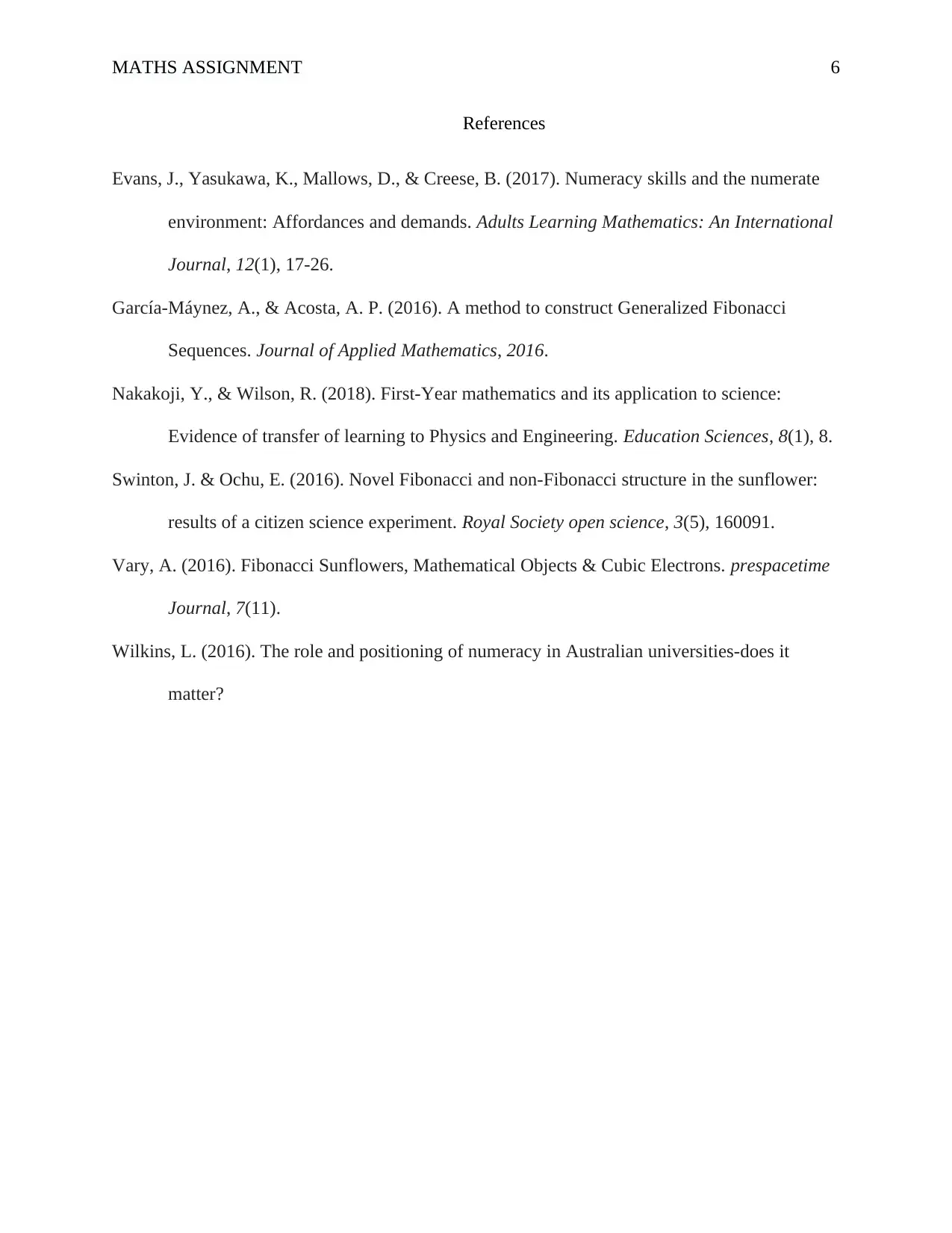
MATHS ASSIGNMENT
References
Evans, J., Yasukawa, K., Mallows, D., & Creese, B. (2017). Numeracy skills and the numerate
environment: Affordances and demands. Adults Learning Mathematics: An International
Journal, 12(1), 17-26.
García-Máynez, A., & Acosta, A. P. (2016). A method to construct Generalized Fibonacci
Sequences. Journal of Applied Mathematics, 2016.
Nakakoji, Y., & Wilson, R. (2018). First-Year mathematics and its application to science:
Evidence of transfer of learning to Physics and Engineering. Education Sciences, 8(1), 8.
Swinton, J. & Ochu, E. (2016). Novel Fibonacci and non-Fibonacci structure in the sunflower:
results of a citizen science experiment. Royal Society open science, 3(5), 160091.
Vary, A. (2016). Fibonacci Sunflowers, Mathematical Objects & Cubic Electrons. prespacetime
Journal, 7(11).
Wilkins, L. (2016). The role and positioning of numeracy in Australian universities-does it
matter?
6
References
Evans, J., Yasukawa, K., Mallows, D., & Creese, B. (2017). Numeracy skills and the numerate
environment: Affordances and demands. Adults Learning Mathematics: An International
Journal, 12(1), 17-26.
García-Máynez, A., & Acosta, A. P. (2016). A method to construct Generalized Fibonacci
Sequences. Journal of Applied Mathematics, 2016.
Nakakoji, Y., & Wilson, R. (2018). First-Year mathematics and its application to science:
Evidence of transfer of learning to Physics and Engineering. Education Sciences, 8(1), 8.
Swinton, J. & Ochu, E. (2016). Novel Fibonacci and non-Fibonacci structure in the sunflower:
results of a citizen science experiment. Royal Society open science, 3(5), 160091.
Vary, A. (2016). Fibonacci Sunflowers, Mathematical Objects & Cubic Electrons. prespacetime
Journal, 7(11).
Wilkins, L. (2016). The role and positioning of numeracy in Australian universities-does it
matter?
6
⊘ This is a preview!⊘
Do you want full access?
Subscribe today to unlock all pages.

Trusted by 1+ million students worldwide
1 out of 6
Related Documents
Your All-in-One AI-Powered Toolkit for Academic Success.
+13062052269
info@desklib.com
Available 24*7 on WhatsApp / Email
![[object Object]](/_next/static/media/star-bottom.7253800d.svg)
Unlock your academic potential
Copyright © 2020–2025 A2Z Services. All Rights Reserved. Developed and managed by ZUCOL.





